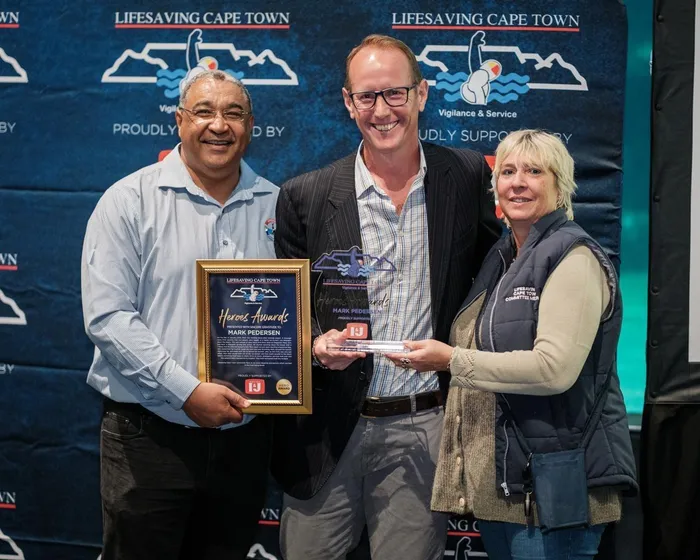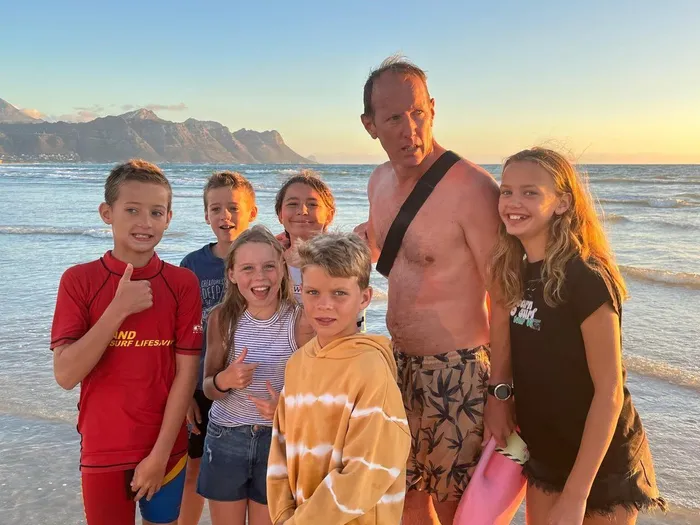Lifesaver honoured for heroic rescue

At the awards ceremony from left, are Melvyn Shaw, Director of Lifesaving at Lifesaving South Africa (LSA); award winner Mark Pedersen; and Christine Kennedy, chairperson Western Cape Lifesaving.
Image: Supplied
Somerset West resident Mark Pedersen has been recognised for his actions during a rescue mission at Strand Beach which resulted in him saving not one, but two people.
He received the I&J Lifesaving Cape Town Heroes Award at a ceremony held at the Two Oceans Aquarium on Saturday, June 21.
He said: “I’m really not the type of person motivated by recognition and awards - that’s just not how I’m wired, but I’m really grateful and hopeful that this award can inspire other children to join the nippers and learn how to save lives.”
The I&J Lifesaving Cape Town Heroes Awards is an annual event, launched in 2019 and organised through a partnership between sponsor I&J and Lifesaving Cape Town. It aims to honour lifeguards for saving people during the previous summer season.
Lifesaving Cape Town said the objective of the event is to shine a light on the heroic acts of lifeguards. “The purpose of the event is to give recognition to some of Cape Town's Lifeguards who have performed selfless rescues not only during duty hours but also outside of them. The rescue is not limited to being in Cape Town. Many rescues are performed off duty and when on holiday, ” they said.
Nominations are submitted by Cape Town lifesaving clubs, gathered from media reports, and put forward by family or friends. Mr Pedersen was nominated by Diane Craemer, a Lifesaving Cape Town volunteer, after she read about the incident in the media.
Mr Pedersen, a nipper coach at the Strand Lifesaving Club, was involved in a rescue on the evening of Friday, January 31. After a coaching session had ended and the other lifesavers had left, a security guard alerted him to a drowning incident nearby.
“It was after a coaching session at about 7pm, and by that time all the lifesavers had left for the day, but we were still on the beach when a security guard came running to the beach looking for help from lifesavers as there was a drowning happening,” he said.
He acted immediately. “I took off my T-shirt and started running. My wife called me back to grab the buoy, then I started sprinting about a kilometre towards where the crowd was pointing.”
Mr Pedersen swam approximately 150 to 200 metres into the sea, where he found two people caught in a rip current. He said he had to make a quick decision whether to attempt to save one person or both.
“In a split-second I had to decide whether to leave the lady and swim to her brother, or to leave her and try and save him, but I then decided to save both and towed her to her brother, where I got to him just in time.”
He managed to tow both victims out of the rip current and swam with them to about 30 metres out of the sea, to where others were able to assist.
“You’ve got seconds to know what to do. It was tough having to rescue two people and it was quite stressful to decide whether to rescue both. Physically, I pushed myself to the limit.”
He injured his neck and back during the rescue, but credited his physical and mental preparation for the successful outcome. “I’ve been a lifesaver since I was a teenager and I’m now in my mid-40s. My motivation is that we train to save lives, that’s why I’m always looking to help and didn’t hesitate to respond to the swimmers in trouble.”
He emphasised the importance of understanding rip currents and being properly trained before attempting such rescues. “If you don’t have that knowledge of how to deal with rip currents, this shouldn’t be something you attempt. That’s the main message I want to emphasise; people need to be educated on this.”
In response to what motivated him to act and immediately go into rescue mode on that day, he said: “I’ve been a lifesaver since when I was a teenager and I’m now in my mid 40’s and my motivation is that we train to save lives, that’s why I’m always looking to help and didn’t hesitate to respond to the swimmers in trouble.
Mr Pedersen said the rescue was witnessed by young nippers, which made the experience even more meaningful. “These young kids watched this play out in real life, seeing how actual lives are saved. Lifesaving is the only sport in the world with humanitarian benefit – the goal is always to save lives.”
Of the award, Mr Pedersen said: “It’s interesting cause I feel very proud, but more than pride, it’s feeling pleased and grateful that I was there at the right place at the right time to be able to help, and even more grateful that my young nippers were there to see the positive ending.
“It’s nice to be recognised and get a platform to get the message of safety out,” he said.
He recalled another rescue at Camps Bay about five years ago, in which he saved three people but received no recognition.
“So getting this recognition was nice and I think it’s important, so that the focus is on how we can be better prepared to prevent these incidents from happening, to get more children to learn about water safety and get them to join the nippers, and possibly get more stakeholders on board to help spread the message of safety and awareness to more people.”
He encouraged the public to visit the Strand Lifesaving Club's website for more information on their programmes and the work they do.

Mark Pedersen from Somerset West, pictured here right after the traumatic event when he rescued two swimmers from drowning earlier this year at Strand Beach. Mark can be seen with some of the nippers, from left in the back are Evan and Ruhan Conradie, both 12; and Annalizé du Plessis, 10; and in front are Ruby and Charlie Lapinski, 9; and Mark's own daughter on the far right, Isabella Pedersen, 12.
Image: Supplied
Related Topics: